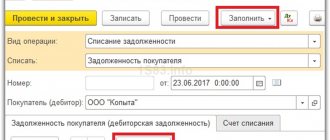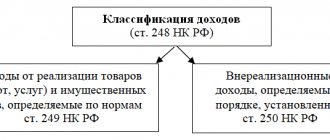Reasons for blocking a current account by the tax office
As one of the measures to influence a taxpayer or tax agent (legal entity or individual entrepreneur) who violates the requirements of tax legislation, a procedure such as blocking current accounts is applied, which is a ban on the use of funds belonging to the taxpayer.
Such a ban is imposed by the tax authority, and the same body lifts it when the grounds that served as the reason for the blocking disappear. The blocking rules are set out in Art. 76 of the Tax Code of the Russian Federation, included in Chapter. 11 of this document, dedicated to the methods used to ensure payment of tax payments. However, non-payment of taxes is not the only reason for banning the use of accounts.
In addition to unpaid tax (penalties, fines), the following are grounds for freezing settlement transactions (clause 3 of Article 76 of the Tax Code of the Russian Federation):
- failure to submit a tax return within 10 working days from the end of the period allotted for its submission - in this case, the account can be blocked for a 3-year period, counted from the date corresponding to the 10th working day from the date of expiration of the period allotted to submit a declaration;
- unrealized obligation to provide an electronic method of interaction with the tax service - liability here arises if the taxpayer has not taken any action within 10 business days from the date the Federal Tax Service Inspectorate discovered such a violation;
- failure to send an electronic confirmation receipt to the Federal Tax Service Inspectorate in response to information received from the tax authority within 10 working days from the date of expiration of the deadline established for sending such a document (it is 6 working days).
In addition, the following may lead to account blocking:
- failure to send a summary calculation for personal income tax (form 6-NDFL) within 10 working days from the end date of the period allotted for its submission (clause 3.2 of article 76 of the Tax Code of the Russian Federation);
- the need to ensure guaranteed implementation of decisions on the payment of additional assessments made during the tax audit (clause 10 of Article 101 of the Tax Code of the Russian Federation).
Responsibility in the form of freezing an account can be applied not only to a taxpayer (payer of insurance premiums) or a tax agent, but also to a tax evader if he is required to file declarations or reports on contributions (subclause 3, clause 11, article 76 of the Tax Code of the Russian Federation).
A credit organization does not have the opportunity not to comply with the decision of the tax authority to block an account (clause 6 of Article 76 of the Tax Code of the Russian Federation). At the same time, she is obliged to inform the tax authority about the balances on blocked accounts (clause 5 of Article 76 of the Tax Code of the Russian Federation).
Account blocking options
A ban on expense transactions can be imposed on any of the accounts belonging to the guilty taxpayer, including an account opened in foreign currency or precious metals. An exception to this rule applies to special election accounts and special accounts of referendum funds - they cannot be blocked (clause 1 of Article 76 of the Tax Code of the Russian Federation).
Read about whether it is possible to block a collateral account here.
Either a specific amount or the entire balance on the account may be blocked on the account, regardless of its value and its change during the blocking period. That is, in the first case, using the account is possible, but there must always be an amount on it that is equal to or greater than the blocked one. It is permissible to use the funds forming the blocked amount only to repay tax payments or those whose transfer order turns out to be higher than that of taxes (Clause 1 of Article 76 of the Tax Code of the Russian Federation).
A limit on a certain amount is adopted by the tax authority in order to collect unpaid tax payments (taxes, contributions, penalties, fines), the specific amount of which is easy to determine. In this situation, the decision to block must be preceded by a decision to collect the relevant payment(s). It will contain a ruble amount, by the amount of which, when a foreign currency account or an account in precious metals is frozen, the blocked amount of currency (at its exchange rate) or precious metals (at the discount price) will be recalculated, respectively. Both the exchange rate and the discount price of precious metals are determined by their value corresponding to the day the ban on the use of funds begins (clause 2 of Article 76 of the Tax Code of the Russian Federation).
Blocking the accounts of an investment partnership if there are insufficient funds in the general account can lead to a limitation in the ability to use the account with the managing partner, and if this turns out to be insufficient, then liability will be proportionally imposed on ordinary partners (clause 2.1 of Article 76 of the Tax Code of the Russian Federation). In a consolidated group of taxpayers, similar measures are applied first to the responsible participant, and then to others (clause 13 of Article 76, clause 11 of Article 46 of the Tax Code of the Russian Federation), and the sequence of this involvement is determined by the tax authority.
When blocking is carried out due to violations that are not assessed in monetary terms (failure to submit reports, failure to provide electronic communication with the Federal Tax Service, or violation of the procedure for confirming the receipt of information from the tax authority), the account cannot be used for any expense transactions. For a consolidated group of taxpayers that has not submitted a profit declaration, liability in the form of account blocking may arise simultaneously for all participants (clause 13 of Article 76 of the Tax Code of the Russian Federation).
Read about the situations in which freezing an account would be illegal here.
How is information about account freezing communicated to the taxpayer?
The Tax Code of the Russian Federation (clause 4 of Article 76) instructs the tax authority to inform the taxpayer about the freezing of an account no later than the first business day following the day such a decision was made. This is done by sending him a copy of the document reflecting the decision to block, in a way that allows him to confirm the fact and date of receipt.
At the same time, the deadlines for sending a decision to suspend operations on an account to the bank are not specified in the Tax Code of the Russian Federation. Only regulated (Article 76):
- the method of sending this document is electronic (clause 4);
- the moment of the blocking itself - it coincides with the moment the bank receives the decision of the tax authority (clause 7).
Obviously, the tax authority is not interested in delaying the sending of the blocking decision for execution, and it is sent to the bank immediately after adoption. At the same time, an additional day is given to notify the taxpayer of the application of this procedure. Therefore, most often he learns about the freezing of an account from the bank that received the information earlier.
At the same time, there is a way that makes it possible to independently check whether an account is blocked by the tax office and find out about it at least simultaneously with the bank.
Actions in the presence of restrictions
If the account is blocked, debit transactions are not possible. Finding out about account blocking on the tax website is the first step to solving the problem. Next, you need to figure out what caused such actions by the tax authorities, especially if the Federal Tax Service did not send an official document indicating the grounds and amounts. After all, there is always the possibility of a system failure.
Read more: What documents are needed to re-register a car?
You can check online at any time whether your current account is blocked by the tax office. Since this service allows you to find out the decision numbers, finding out the details on them will not be difficult.
If the tax authorities made a mistake, the department will have to compensate the victim for losses. It pays interest in the amount of the refinancing rate for each day of inactivity.
If the sanction was imposed lawfully, the money will have to be paid. You can do this voluntarily, or you can wait for the first receipts - the funds will be debited automatically.
What else is blocking fraught with and how to find out about it online
The data from this service may also be of interest to potential clients considering a draft contract proposed for conclusion, since the presence of blocking of the account of a future counterparty most often indicates that he has problems with funds.
- Of the proposed types of requests, you should note the request for decisions on suspension.
- Indicate in the field provided for this purpose the TIN of the person for whom information is needed.
- In the field reserved for displaying the BIC, enter the BIC of a bank.
- Enter a digital cipher in another field that serves as protection against spam.
After a short processing, the service will issue a response to the request, which will either indicate the absence of valid decisions to suspend transactions on accounts, or a table will appear containing data on the numbers and dates of decisions made on blocking, the code of the tax authority that made the decision, the BIC of the bank, in which it was sent, and information about the date and time of posting information about the blocking on the service. The generated data can be printed.
Possibilities of Contour.Reconciliation
The VAT+ module (Contour.Reconciliation) will help users solve several problems at once:
- check the correctness of the counterparty details;
- assess the trustworthiness of a potential or new partner;
- check with counterparties before sending a VAT return.
Directory of counterparties
Check the correctness of your counterparties' data - this will eliminate errors in their parameters. To do this, create a directory of counterparties in the accounting system and upload it to Kontur.Sverka. You can also upload Purchase and Sales Books to the service, and the specified directory will be generated automatically and will contain data on the name of the organization, its INN and KPP. Next, you will need to add a contact person and email address for each partner. Which method of entering the directory to choose is a matter of your preference.
The service will check the data in your directory of counterparties with information from the tax authorities’ databases. Those details that he considers incorrect will be highlighted in red. Now you need to double-check them and correct errors in your accounting system, and then re-upload the data into Kontur.Sverku.
Trustworthiness of partners
The system also allows you to preliminarily assess the reliability of the partner company. Information about suspicious factors comes to the service from another development of SKB Kontur - the Kontur.Focus system, created specifically for assessing counterparties. It works on the basis of many registries of government agencies, as well as other open data sources.
The list of your counterparties will be marked in different colors depending on the absence or presence of suspicious factors. A green marker means that no such companies have been identified, a red one indicates the liquidation of the company, and an orange one requires paying closer attention to it. By clicking on the marker, you can see a company card containing the relevant explanations.
Verification with partners
Reconciliation in the service is a very convenient and fast process. You just need to click the “Upload purchase/sales books and start reconciliation” button and evaluate the result.
Upon completion of the reconciliation, all counterparties will be collected into 4 groups:
- With disagreements. Organizations with which there are discrepancies in invoice data. Clicking will open a table for each invoice, in which discrepancies will be highlighted. You can discuss them with your partner directly in the system. The party that made the error must correct it in its accounting system.
- No disagreement. Companies with which data comparison was successful.
- Haven't checked yet. Counterparties who have not yet uploaded their data to the service. If you haven’t found one of your partners in Kontur.Sverka, enter their details in the “Contact person” field, and the service will send them an invitation to undergo verification. He can check with your company for free.
- With mistakes. Organizations whose details contain errors. For example, the TIN is indicated incorrectly, there is no registration in the Unified State Register of Legal Entities, etc.
All discrepancies and errors should be eliminated in the accounting system, and then the data should be re-uploaded to the service. Now you can be sure that the VAT return will not raise questions either from the tax service information system or from its specialists. Thus, you will protect the company from the risk of additional VAT charges, penalties and other troubles associated with errors in the declaration.
Results
Blocking a current account is one of the measures to influence tax payers who violate the requirements of the Tax Code of the Russian Federation. The main reason for its use is non-payment of taxes. However, there are other reasons why an account may be frozen. Due to non-payment of taxes, accounts are blocked for the amount of the existing debt. In this case, the ability to use the account remains, but is subject to the presence of a minimum balance on it. In other situations, the account is frozen completely.
To combat tax arrears and failure to submit reports, the Federal Tax Service has an effective tool - blocking a current account. Moreover, the Tax Service can block amounts in the accounts of companies and entrepreneurs directly, and not through the court. Therefore, when checking in the bailiffs’ database, there may not be any debts, but in reality the tax office has already imposed a grievance on the account.
When can the Federal Tax Service block an account?
The rules for imposing restrictions on expense transactions, as well as on the transfer of electronic funds, are given to the Tax Service by Article 76 of the Tax Code of the Russian Federation. The decision to block an account is made by the head of the tax authority or his deputy. There are several reasons for this:
- the taxpayer did not comply with the inspection’s request to pay the tax, penalty or fine;
- the taxpayer did not submit a tax return within 10 days after the deadline for its acceptance;
- the taxpayer did not provide explanations or documents requested by the Federal Tax Service within the prescribed period.
If there are not enough funds in the account, then the payment according to the decision of the Federal Tax Service will be put in a queue. In this case, all payments incoming to the account will be accepted without restrictions, and write-offs will occur in accordance with the priority established by Article 855 of the Civil Code. Tax arrears according to tax regulations are paid off in third place.
- TIN. You need to enter the TIN of the taxpayer whose account you want to obtain information about.
- BIC. The service is intended for banks, so it is supposed to include the BIC of the bank that generates the request. An ordinary user can enter any real BIC.
As we can see, in relation to the accounts of the taxpayer under audit, there are decisions to suspend transactions on current accounts. In the table below, the system shows their details. Information about the reasons for blocking and the amount of arrears is not shown.
Checking for blocking: step-by-step instructions
In order to obtain information about blocking an account on the tax website, you need to perform only 2 steps.
Step 1. Login to the information system
The check takes place online in a few seconds. To do this, you must select in the information system.
Step 2. Fill out the form and receive results
A form for filling out information appears on the same page. The TIN is required for the taxpayer for whom information is needed. You can take the BIC of any bank - this will not affect the result.
After clicking the “Send request” button, the necessary information will appear.
Blockage detected. What to do?
Most often, blocking occurs due to non-payment of mandatory payments. At the same time, theoretically, the taxpayer should have a demand from the inspectorate about the need to repay the debt. That is, he must know that arrears have been identified. But in practice this does not always happen. Therefore, information about account blocking often comes as a surprise to the taxpayer. For example, a typical situation: restrictions are imposed on the account due to an underpayment of several rubles.
What should a taxpayer do? As you can see, the Federal Tax Service provides information about the number of the decision to suspend operations on the account. You should contact your tax office and find out why this decision was made. Mistakes happen, and often. For example, the payment was made on time, but the Federal Tax Service did not receive information about it. By the way, to avoid such misunderstandings, it is recommended to periodically reconcile with the tax authority.
If in the end it turns out that the blocking was not imposed without reason, then the arrears must be paid. It is better to do this voluntarily, but you can wait until the money appears in the account and the amount will be debited automatically.
What might cause discrepancies?
There may be several reasons for data inconsistency. The most common of these are poor record keeping and mechanical errors.
The counterparty violates accounting rules
There is a risk that, due to inattention or negligence, a partner may violate accounting rules. For example, a supplier may “forget” to register an invoice in the Sales Book in the period when the goods were sold. Or do this in another period when the specified document was issued and received by the buyer. The result of such a violation can be disastrous - the Federal Tax Service will consider the fact of sale of products to be undocumented.
The presence of companies that deliberately evade taxes cannot be discounted. The risk of choosing such a “fly-by-night” as a partner can lie in wait for even the most cautious businessman. As a result, the accounting department of a bona fide taxpayer will have to respond to the demands of the tax authorities and provide explanations due to the violations of their “unclean” counterparties.
Errors associated with manual data entry
Errors often occur when an accountant enters information from “paper” invoices into the accounting system.
Most often, parameters such as date, amount, invoice number and organization tax identification number are entered incorrectly. Moreover, according to practice, the number of such errors is very large.
This fact was revealed when large taxpayers checked their partner directories through a special service of the Federal Tax Service. As a result, it turned out that the directories contain errors in the parameters of almost a third of the counterparties.
Often, errors creep into an organization’s TIN. In this case, during reconciliation, the automated Federal Tax Service system simply will not find the counterparty in its database. This will most likely lead to questions from inspectors about the validity of the tax benefit received by the buyer. If such a situation occurs occasionally, then there is nothing to worry about - the accountant will just need to provide an appropriate explanation. However, if there are a large number of incorrectly specified TIN (or other parameters), the company’s accounting department risks getting bogged down in the endless process of communication with the tax office.
Blocking of the current account by the tax office
- payments for taxes, fines, penalties and insurance contributions to the budget. To make such a transfer, send a payment order to the bank. He is obliged to fulfill it;
- payments, the order of which precedes the payment of taxes, fees, fines and penalties. These include:
- 1st stage - payments for compensation for harm to life and health, on the basis of writs of execution and claims for alimony;
- 2nd stage - payment of vacation pay and wages to resigning employees; payment under copyright agreements;
- 3rd stage - payroll settlements with working employees, requirements for payment of taxes, fees, fines and penalties.
- have all deadlines been met;
- whether the amount of non-payment is indicated;
- whether the documents are signed by an authorized person (the head or deputy head of the Federal Tax Service and with the seal of the tax authority);
- whether the decision to collect or suspend transactions on the current account refers to the claim.
Where to view the decision on collection by number
It is not necessary to check the writ of execution by its number. The site's database is equipped with an advanced search, where you can specify all the data about the case you are looking for or some of the information known to it without having the enforcement proceedings number, and the search will produce a list of cases that match the information in the request.
Signing of the declaration by an unauthorized person. The inspection interviewed the head of the one-day company, who said that he did not sign the company’s declarations. From this, the Federal Tax Service Inspectorate concluded: the declarations were signed by an unauthorized person, that is, they were not signed, that is, they were not submitted. And on the basis of clause 3 of Art. 76 The Tax Code of the Russian Federation blocked the account. The court overturned the inspection decision, since the manager was included in the Unified State Register of Legal Entities, the interviewee did not indicate a specific declaration, the company recognizes the reporting, etc. (see resolution of the Federal Antimonopoly Service of the Ural District dated March 21, 2014 N F09-1036/14).
Account blocking: causes, consequences and guidelines for action
The blocking of a bank account is valid from the moment the bank receives the inspector’s decision to suspend operations on the accounts and until it is cancelled. This decision is made by the head or deputy head of the Federal Tax Service, and the form of the decision to suspend transactions on accounts was approved by order of the Federal Tax Service of Russia dated February 13, 2021 No. ММВ-7-8/ [email protected]
Organizations and individual entrepreneurs must confirm the acceptance of three types of electronic documents sent by the Federal Tax Service: requirements for the submission of documents, requirements for the provision of explanations, as well as notifications of a call to the inspection. Confirmation of receipt of documents occurs by sending electronic receipts to the Federal Tax Service regarding receipt of such requirements and notifications. The receipt must be sent within 6 business days from the date they were sent by the tax authority.
Now you can easily check the current accounts of any company
— Decisions of tax authorities to lift the suspension of operations sent to banks exclusively in electronic form have legal force. The legislation does not provide for other methods of delivering such decisions. But, in my opinion, in exceptional cases such decisions can be sent on paper. For example, if there are some technical problems and the bank cannot receive a solution in electronic form.
— Last summer, the Federal Tax Service of Russia launched a new service “BANKINFORM”. Since January 2014, this service allows banks to receive information about the suspension of transactions on accounts. To do this, at service.nalog.ru/bi.do you must enter the taxpayer’s INN and BIC of the bank on whose behalf the information is being verified. In response, the system will show whether the decision to suspend expenditure transactions is currently in effect for the taxpayer. If yes, then the date of the blocking decision and the code of the tax authority that made this decision will be shown.
Where to view the decision on collection by number
Situations often arise when a person is aware of the decision regarding his order, but for some reason does not receive it. The debtor is interested in the timely execution of this order (so as not to receive an additional fine) or appealing it (if there is evidence of his innocence).
The Federal Tax Service website operates a service that allows third parties to obtain information about organizations that have not submitted tax reports for more than a year; there you can also view tax debts over 1,000 rubles, aimed at collection by bailiffs. To do this, just indicate the TIN of the organization you are interested in.
How to find out if you owe taxes
All taxes must be paid on time. Unfortunately, taxpayers do not always remember this in a timely manner; as a result, tax arrears arise and penalties and fines are accrued. How to check whether an organization or an individual has tax debts, and whether you always need to go to the tax office for this - we will tell you in this article.
Any taxpayer can request from his tax office a certificate of the status of settlements with the budget as of a certain date. The request is submitted in writing, the form of which can be found in Appendix No. 8 to Order No. 99n of the Ministry of Finance of the Russian Federation dated July 2, 2012. You can send a request about your tax debt not only by visiting the inspectorate in person, but also by mail, as well as electronically via TKS channels, or through the “Taxpayer Personal Account” on the Federal Tax Service website.
Suspension of transactions on taxpayer accounts
Suspension of transactions on accounts is the cessation by the bank servicing the taxpayer of expenditure activities on his account in full or within a limited amount determined by the decision of the tax authority on suspension for a legal entity. Blocking occurs only for expenses. Funds continue to flow into the account.
- Compensation for harm caused to life and health, and payment of alimony;
- Settlement with dismissing employees, which includes the balance of the last month’s salary, compensation, severance pay, and remuneration for authors for intellectual products;
- Fulfillment of duties regarding taxes, fees, insurance premiums, penalties and fines.
Video on the topic
Find out debts
Author:
Vladislav Kvitchenko
CEO . Practicing lawyer in the field of bankruptcy of individuals. persons Since 2015, she has been successfully handling insolvency cases. Vladislav is brilliantly versed in bankruptcy law, gives expert comments on legal situations and actively publishes in specialized publications.
How to obtain information about the suspension of transactions on taxpayer accounts - verification methods
One of the most effective means of influencing a taxpayer is the suspension of any banking transactions on his accounts. The main idea of the innovation is to prohibit any banks, under threat of penalties, from opening new accounts with individuals and organizations that have been subject to similar sanctions. To systematically check information about all accounts blocked by the tax authorities, an electronic system for informing banks about the suspension of operations was introduced.
According to Article 76 of the Tax Code of the Russian Federation, the bank sets a limit on all debit transactions of the client, as directed by the Federal Tax Service, although crediting to the account and working with deposits is permitted. Blocking of accounts applies to individuals and legal entities and individual entrepreneurs. The exception is the payments prescribed in the same regulatory act, the execution of which is carried out according to the established priority.
Ways to solve the problem
There are two ways to reduce the likelihood of errors:
- minimizing the “manual work” of entering data into the accounting system and
- conducting preliminary reconciliations with your counterparties.
These ways are not interchangeable - they complement each other perfectly and make it possible with a high degree of probability to avoid sanctions during a desk audit for VAT.
Transition to EDI
Electronic document management (EDF) allows the buyer and seller to use the same electronic document in accounting. Therefore, the risk of data discrepancies is completely eliminated. It is especially convenient if the accounting system and the EDI system used by the company are integrated with each other - in this case, invoices will be accepted for accounting automatically.
However, completely switching to EDI is problematic for many companies. Some organizations, especially small firms and individual entrepreneurs, manage document flow using the web version of the service, which requires manual receipt of documents for accounting. Thus, the influence of the human factor on the document flow process is not completely excluded.
Data reconciliation with counterparties
The most reliable way to eliminate discrepancies is to first carry out the same reconciliation process that will be carried out by the Federal Tax Service information system. Of course, you can try to do this manually, but it’s easier and more reliable to do it automatically.
With the “manual” method, a corresponding reconciliation report is generated for each counterparty, then they are sent out by mail (electronic or regular mail, depending on the presence or absence of EDI). The partner checks the received acts with his accounting data - he will have to do this, again, manually. The company does not have much time for this entire process, because at the end of the reporting period it is given only 25 days to report VAT to the tax service .
The disadvantages of the manual approach are obvious:
- the process is very labor-intensive and takes a lot of time, especially with a large number of counterparties;
- The human factor does not eliminate the possibility of error.
These disadvantages disappear when reconciliation is carried out automatically. For this purpose, special services have been created today, for example, the VAT+ module (Kontur.Sverka) from the SKB Kontur company.
Suspension of transactions on bank accounts
Suspension of movement on an account in case of non-payment of tax is structured in such a way as coercion to fulfill the legal requirements of the tax authority. At the same time, it is assumed that the constitutional principle of protecting property is observed and that the infliction of unreasonable damage to the taxpayer is limited.
As you know, arrears are possible if taxes are not paid on time, or if arrears are identified during a tax audit. According to the rules of the Tax Code, the taxpayer must be notified by the tax authority about the arrears he has, and he must be asked to pay off the arrears voluntarily. In each case of detection of arrears, the tax authority has the right to send the taxpayer a demand for tax payment (Chapter 10 of the Tax Code of the Russian Federation).
The decision on collection where to look by number
There is nothing complicated about using this service. It can be freely used by anyone who is interested in how to find a writ of execution by name and find out about existing debts. Let us remind you that information about the debtor, the writ of execution, and the initiated proceedings is entered into the database. Therefore, knowing only the last name of the debtor, you can get a complete picture of from whom, in what volume and on what grounds the collection is being made.
It is also possible to view the data through social networks using special applications. By subscribing to these applications, you can constantly receive information about the initiation of new individual entrepreneurs. Applications on mobile devices provide a similar opportunity. But first you need to find them, install them, and register. Not everyone wants to spend time installing various applications.
How to find a resolution by resolution number? Search for a traffic police fine by resolution number
If a user has an account on Gosuslugi, he may not think about how to search for a traffic police resolution by the resolution number. The point is that such people have the right to connect SMS alerts. They will send information about existing debts. To connect, you need to do the following:
How to find a resolution by resolution number? As we have already said, you can act through State Services. Before this, the user must register on the service and activate a profile. Otherwise, access to the portal services will be denied. To check a fine by resolution number, you will need:







